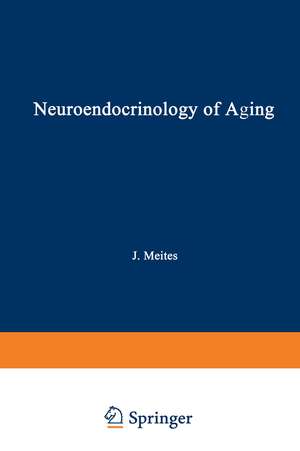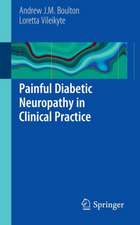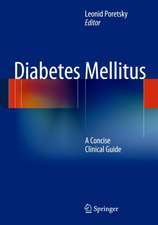Neuroendocrinology of Aging
Editat de Joseph Meitesen Limba Engleză Paperback – 26 mar 2012
Preț: 720.68 lei
Preț vechi: 758.60 lei
-5% Nou
Puncte Express: 1081
Preț estimativ în valută:
137.90€ • 144.37$ • 114.10£
137.90€ • 144.37$ • 114.10£
Carte tipărită la comandă
Livrare economică 07-21 aprilie
Preluare comenzi: 021 569.72.76
Specificații
ISBN-13: 9781468445251
ISBN-10: 1468445251
Pagini: 404
Ilustrații: XVI, 384 p.
Dimensiuni: 152 x 229 x 21 mm
Greutate: 0.54 kg
Ediția:Softcover reprint of the original 1st ed. 1983
Editura: Springer Us
Colecția Springer
Locul publicării:New York, NY, United States
ISBN-10: 1468445251
Pagini: 404
Ilustrații: XVI, 384 p.
Dimensiuni: 152 x 229 x 21 mm
Greutate: 0.54 kg
Ediția:Softcover reprint of the original 1st ed. 1983
Editura: Springer Us
Colecția Springer
Locul publicării:New York, NY, United States
Public țintă
ResearchCuprins
1 Introduction.- 2 Neuroendocrinology of Aging: Retrospective, Current, and Prospective Views.- 1. Introduction.- 2. Retrospection.- 3. Current Neuroendocrine Theories of Aging.- 3.1. The Hypothalamic “Disregulation” Hypotheses.- 3.2. The Neurotransmitter Hypotheses.- 3.3. The Pituitary Hypotheses.- 3.4. Progeria and Progeroid Syndromes.- 3.5. The Stress Theory of Aging.- 4. Outlook.- 4.1. Refinement in Detection of Neuroendocrine Changes with Aging.- 4.2. Comparative Aspects of Neuroendocrine Changes with Aging.- 4.3. Relations between Neuroendocrine and Immune Controls in Aging.- 4.4. Molecular Biology of Brain Hormones and of Hormonal Actions on Brain.- 4.5. Changes with Aging in Hormone Metabolism and Tissue Responses.- 4.6. Oxidative Cell Damage with Aging and Actions of Hormones.- 5. Summary and Conclusions.- 6. References.- 3 Morphological Changes in the Hypothalamus and Other Brain Areas Influencing Endocrine Function during Aging.- 1. Introduction.- 2. Nerve Cell Loss.- 3. Other Morphological Changes.- 4. Hormones as Causative Factors in the Neuronal Degenerative Processes.- 4.1. Estrogens, Prolactin, and the Arcuate Nucleus.- 4.2. Glucocorticoids and the Hippocampus.- 4.3. Estrogens, Prolactin, and Nigrostriatal Neurons.- 5. Brain Lesions That Mimic Age-Related Changes.- 6. Biochemical Evidence for Age-Induced Morphological Changes.- 7. General Summary.- 8. References.- 4 Changes in Hypothalamic Hypophysiotropic Hormones and Neurotransmitters during Aging.- 1. Introduction.- 2. Aging of Dopaminergic Neurons.- 3. Aging of Noradrenergic Neurons.- 4. Aging of Serotonergic Neurons.- 5. Aging of Opioid Neurons.- 6. Aging of Luteinizing Hormone-Releasing Hormone (LHRH) Neurons.- 7. Aging of Somatostatin Neurons.- 8. Aging of Thyrotropin-Releasing-HormoneNeurons.- 9. Summary.- 10. References.- 5 Changes in Hormone Uptake and Receptors in the Hypothalamus during Aging.- 1. Introduction.- 2. Sex Steroid Uptake and Receptor Binding in the Hypothalamus during Aging.- 2.1. Estrogen Receptor Binding.- 2.2. Androgen Receptor Binding.- 2.3. Relation between Changes in Sex Steroid Uptake in the Hypothalamus and Changes in Feedback Response to Sex Steroids during Aging.- 2.4. Relation between Changes in Sex Steroid Binding to Receptors in the Hypothalamus and Changes in Hypothalamic Neuronal Numbers during Aging.- 3. Corticosteroid Uptake and Binding to Receptors in the Hypothalamus during Aging.- 4. Summary.- 5. References.- 6 Relation of Neuroendocrine System to Reproductive Decline in Female Rats.- 1. Introduction.- 2. Preliminary Comments on Hormonal Data in Old Rats.- 3. Relation of Neuroendocrine System to Ovarian Function after the End of Cyclicity.- 3.1. Senile Patterns of Ovarian Function.- 3.2. Aging of the Neuroendocrine Regulation of Ovarian Function.- 4. Relation of Neuroendocrine System to Ovarian Function during Cyclicity and Transition Period.- 4.1. Aging of Ovarian Function during Cyclicity: Physiological and Structural Changes.- 4.2. Aging of the Neuroendocrine Regulation of Cyclic Ovarian Function.- 5. Experimental Manipulations of Hypothalamic-Hypophysial-Ovarian Aging..- 5.1. Suspended Aging.- 5.2. Retarded Aging.- 5.3. Advanced Aging.- 6. Extrinsic and Intrinsic Aging.- 7. Conclusions.- 8. References.- 7 Changes in Ovarian Function and Gonadotropin and Prolactin Secretion in Aging Female Rats.- 1. Introduction.- 2. Changes in Ovarian Function.- 3. Changes in Gonadotropin Secretion.- 4. Changes in Prolactin Secretion.- 5. Alterations in Ovarian Steroid and Periovulatory Gonadotropin Secretion Preceding Cessation of Regular Estrous Cycles.- 6. Conclusions.- 7. References.- 8 The Reproductive Decline in Male Rats.- 1. Introduction.- 2. Testicular Structure and Function.- 2.1. Testicular Histology.- 2.2. Sperm Count and Fertility.- 2.3. Serum Steroid Levels.- 2.4. Gonadotropin Response of the Old Testes.- 2.5. Steroid Clearance.- 3. Pituitary Structure and Function.- 3.1. Morphology.- 3.2. Basal Gonadotropin Levels.- 3.3. Steroid Negative Feedback.- 3.4. Pituitary LHRH Response.- 4. Aging of Male Sex Accessory Organs.- 5. Summary and Conclusions.- 6. References.- 9 Hormonal Influences on Hypothalamic Sensitivity during Aging in Female Rodents.- 1. Introduction.- 2. Overview of Rodent Reproductive Senescence.- 2.1. Phenomenology.- 2.2. Effects of Altered E2:P Ratios.- 2.3. Negative Feedback.- 2.4. Positive Feedback.- 2.5. Prolactin and Pituitary Responsiveness.- 2.6. Progesterone-LH Interactions at Proestrus.- 3. Effects of Ovariectomy on Manifestations of Neuroendocrine Aging.- 3.1. Long-Term Ovariectomy and Ovarian Transplants.- 3.2. Long-Term Ovariectomy and Pituitary Tumors.- 3.3. Ovariectomy of Noncycling Rodents.- 4. Postnatal Steroidal Influences.- 4.1. The Neonatal Anovulatory Syndrome.- 4.2. The Delayed Anovulatory Syndrome.- 4.3. Long-Lasting Steroid Effects in the Postweaning Period.- 4.4. Estradiol-Induced Adult Anovulatory Syndrome.- 4.5. Light-Induced Anovulatory Syndrome.- 5. Mechanisms.- 6. References.- 10 Pathophysiology of Menopausal Hot Flushes.- 1. Introduction.- 2. Physiological Studies.- 3. Hormonal Studies.- 3.1. Gonadotropin Studies.- 3.2. Estrogen Studies.- 3.3. Adrenal Studies.- 4. Sleep Studies.- 5. Treatment.- 6. References.- 11 Relation of the Neuroendocrine System to Reproductive Decline in Men.- 1. Introduction.- 2. Testis.- 3. Pituitary.- 4. Hypothalamus.- 5. Sex Hormones and Sexual Function.- 6. References.- 12 The Sexual Psychoendocrinology of Aging.- 1. Introduction.- 2. Male Animals.- 2.1. Endocrinology.- 2.2. Behavior in Rats.- 2.3. Hormone-Behavior Relationships in Rats.- 2.4. Other Species.- 3. Sexuality in Aging Men.- 3.1. What Is Responsible for the Decrease in Sexual Activity?.- 3.2. Hormone-Behavior Relationships.- 4. The Male: Summary Statement and Discussion.- 5. Female Animals.- 6. Women.- 6.1. Sexual Decline and the Menopause.- 6.2. Hormones and Sexuality in Women.- 7. Concluding Discussion.- 8. References.- 13 Regulation of Thyrotropin Physiology during Aging.- 1. Introduction.- 2. Methodological Considerations.- 3. Assessment of the Status of the Feedback System in the Basal State.- 3.1. Circulating Levels of Thyroid Hormones.- 3.2. Studies in Animals.- 3.3. Studies in Man.- 3.4. Regulation of Thyrotropin.- 3.5. Thyrotropin under Basal Conditions and after TRH.- 3.6. Response to TRH.- 3.7. Molecular Aspects of TSH during Aging.- 3.8. Effects of Age on Stress-Induced TSH Secretion.- 3.9. Thyrotropin Secretion during Aging in the Human.- 3.10. Response to Thyrotropin-Releasing Hormone.- 3.11. The Hypothalamo-Pituitary-Thyroid Axis during Stress in the Elderly.- 4. Summary.- 5. References.- 14 Changes in Growth Hormone Secretion in Aging Rats and Man, and Possible Relation to Diminished Physiological Functions.- 1. Introduction.- 2. Alterations in Episodic Growth Hormone Secretion with Age.- 3. Mechanisms Responsible for Alterations in Growth Hormone Secretion with Age.- 3.1. Pituitary.- 3.2. GHRF.- 3.3. Somatostatin.- 3.4. Neurotransmitters.- 3.5. Autoregulation of Growth Hormone Secretion.- 3.6. Other Hormones.- 4. Possible Implications of Attenuated Growth Hormone Pulses in Old Animals and Humans.- 4.1. Somatomedins.- 4.2. Metabolic Function.- 5. Conclusions.- 6. References.- 15 Changes in Hypothalamic Control of ACTH and Adrenal Cortical Functions during Aging.- 1. Introduction.- 2. Adrenal Gland Anatomy.- 3. Anterior Pituitary Anatomy.- 4. Hypothalamic Structure and Hormone Content.- 5. Adrenal Steroid Secretion and Basal Blood Concentrations.- 6. Adrenocortical Response to ACTH.- 7. Responsiveness of the Hypothalamic-Pituitary Unit.- 8. Neuroendocrine Control of Corticotropin-Releasing Hormone.- 9. Summary.- 10. References.- 16 Relation of the Neuroendocrine System to the Development of Mammary Tumors in Rats during Aging.- 1. Hormones and the Genesis and Growth of Carcinogen-Induced Rat Mammary Carcinomas.- 1.1. Role of Prolactin, Estrogen, and Progesterone in the Initiation of Carcinogen-Induced Rat Mammary Carcinomas.- 1.2. Role of Prolactin, Estrogen, and Progesterone in the Growth Promotion of Carcinogen-Induced Rat Mammary Carcinomas.- 1.3. Neuroendocrine Relationships to the Initiation and Promotion of Carcinogen-Induced Rat Mammary Carcinomas.- 2. Age-Associated Changes in Pituitary-Ovarian Activity of Rats.- 2.1. Changes in Estrous Activity in Aging Female Rats.- 2.2. Changes in Serum Estrogens in Aging Female Rats.- 2.3. Changes in Serum Progesterone in Aging Female Rats.- 2.4. Changes in Serum Prolactin in Aging Female Rats.- 3. Incidence of Mammary Tumors in Aging Female Rats: Hormonal Implications.- 4. References.- 17 Relation of the Neuroendocrine System to Development of Prolactin-Secreting Pituitary Tumors.- 1. Introduction.- 2. Regulation of Prolactin Secretion.- 3. Spontaneous Pituitary Tumors in Animals and Man.- 4. Experimental Induction of Pituitary Tumors.- 4.1. Estrogen-Induced Pituitary Tumors.- 4.2. Irradiation-Induced Pituitary Tumors.- 4.3. Transplantation of Pituitary.- 5. Hypothalamic Relationships in Development of Prolactin-Secreting Pituitary Tumors.- 5.1. Pituitary Growth Stimulation by Estrogen.- 5.2. Pituitary Growth Inhibition by Dopamine.- 5.3. Neurotoxic Action of High Prolactin Secretion on Dopaminergic Neurons.- 5.4. Possible Role of Hypothalamic Stimulatory Agents on Pituitary Tumors.- 6. Reduction of Hypothalamic Dopaminergic Activity Is Associated with Development of PRL-Secreting Pituitary Tumors in Old Rats.- 7. Use of Ergot Drugs for Producing Regression of Pituitary Tumors.- 8. Summary.- 9. References.











